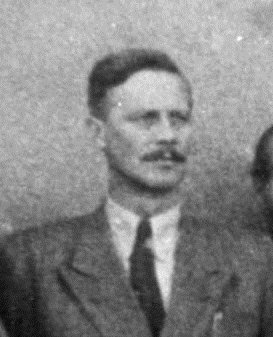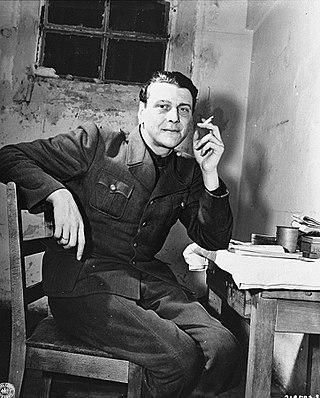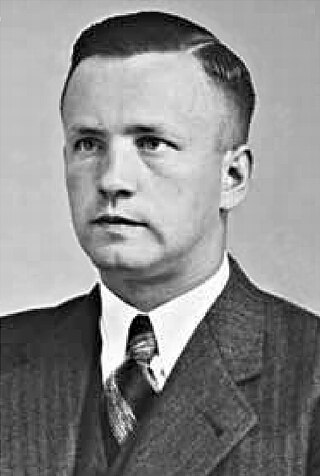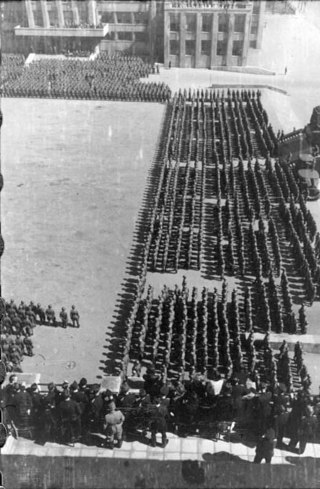Related Research Articles

Heinrich Müller was a high-ranking German Schutzstaffel (SS) and police official during the Nazi era. For most of World War II in Europe, he was the chief of the Gestapo, the secret state police of Nazi Germany. Müller was central in the planning and execution of the Holocaust and attended the January 1942 Wannsee Conference, which formalised plans for deportation and genocide of all Jews in German-occupied Europe—The "Final Solution to the Jewish Question". He was known as "Gestapo Müller" to distinguish him from another SS general named Heinrich Müller.
Horst Kopkow was a Nazi German SS major who worked for German Security police and, after the war, was concealed by British intelligence to use his knowledge during the Cold War.
The Nazi War Crimes and Japanese Imperial Government Records Interagency Working Group is a United States government interagency group, which is tasked with locating, identifying, inventorying, and recommending for declassification classified U.S. records relating to Nazi German and Imperial Japanese war crimes.

The ratlines were systems of escape routes for German Nazis and other fascists fleeing Europe from 1945 onwards in the aftermath of World War II. These escape routes mainly led toward havens in Latin America, particularly in Argentina, though also in Paraguay, Colombia, Brazil, Uruguay, Mexico, Chile, Peru, Guatemala, Ecuador, and Bolivia, as well as the United States, Canada, Australia, Spain, and Switzerland.

Count Fidél Pálffy ab Erdőd was a Hungarian nobleman who emerged as a leading supporter of Nazism in Hungary.

Krunoslav Stjepan Draganović was a Bosnian Croat Catholic priest associated with the ratlines which aided the escape of Ustaše war criminals from Europe after World War II while he was living and working at the College of St. Jerome in Rome. He was an Ustaša and a functionary in the fascist puppet state called the Independent State of Croatia.

Robert Wolfe was a World War II U.S. Army officer, historian, and retired senior archivist of the US National Archives. He was wounded in both the Pacific and European Theaters of Operation. He commanded a recon team and also an anti-landmine platoon. He was a subject-matter expert on captured Nazi war documents. Wolfe worked for 34 years at the Archives, functioning as its senior specialist for captured German and related records.
Walter Kopp was a lieutenant colonel in the Wehrmacht in Nazi Germany. After the Nazi defeat in 1945, he became the chief of one stay-behind network in West Germany, code-named KIBITZ-15. The British and US intelligence services had set up clandestine anti-communist organisations supposed to "stay-behind" in case of a Soviet invasion. Walter Kopp was described by his own North-American handlers as an "unreconstructed Nazi," and the KIBITZ-15 network as "a group with Nazi tendencies" in CIA documents released in June 2006.

Martin Sandberger was a German SS functionary during the Nazi era and a convicted Holocaust perpetrator. He commanded Sonderkommando 1a of Einsatzgruppe A, as well as the Sicherheitspolizei and SD at the time of Nazi German occupation of Estonia during World War II. Sandberger perpetrated mass murder of the Jews in German-occupied Latvia and Estonia. He was also responsible for the arrest of Jews in Italy, and their deportation to Auschwitz concentration camp. Sandberger was the second-highest official of the Einsatzgruppe A to be tried and convicted. He was also the last-surviving defendant from the Nuremberg Military Tribunals.

Mykola Kyrylovych Lebed or Lebid, also known as Maksym Ruban, Marko or Yevhen Skyrba, was a Ukrainian nationalist political activist and guerrilla fighter. He was among those tried, convicted, and imprisoned for the murder of Polish interior minister Bronisław Pieracki in 1934. The court sentenced him to death, but the state commuted the sentence to life imprisonment. He escaped when the Germans invaded Poland in 1939. As a leader of OUN-B, he was responsible for the massacres of Poles in Volhynia and Eastern Galicia.
While the United States was involved in the prosecution of people involved in the war crimes of World War II, US military and intelligence agencies protected some war criminals in the interest of obtaining technical or intelligence information from them, or to recruit them for intelligence work. The relationships with German war criminals started immediately after the end of the Second World War, but some of the relationships with Japanese war criminals were slower to develop.

Die Spinne was a post-World War II organisation that helped certain Nazi war criminals escape persecution. Its existence is still debated as of 2023. It is believed by some historians to be a different name for, or a branch of ODESSA, an organisation established during the collapse of Nazi Germany, similar to Kameradenwerk and der Bruderschaft, and devoted to helping German war criminals flee Europe. It was led in part by Otto Skorzeny, as well as by German intelligence officer Reinhard Gehlen. Die Spinne helped as many as 600 former SS men escape from Germany to Francoist Spain, Juan Peron's Argentina, Paraguay, Chile, Bolivia, the Middle East and elsewhere.
Walter Huppenkothen was a German lawyer, Sicherheitsdienst (SD) leader, and Schutzstaffel (SS) prosecutor in the Hauptamt SS-Gericht.
Helmut Beck-Broichsitter was a German Wehrmacht officer during World War II. Following the war, Beck-Broichsitter was involved in several neo-Nazi movements.

Eugen Dollmann was a German diplomat and member of the SS.
The assertion that the Holocaust was a unique event in human history was important to the historiography of the Holocaust, but it has come under increasing criticism in the twenty-first century. Related claims include the claim that the Holocaust is external to history, beyond human understanding, a civilizational rupture, and something that should not be compared to other historical events. Uniqueness approaches to the Holocaust also coincide with the view that antisemitism is not another form of racism and prejudice but is eternal and teleologically culminates in the Holocaust, a frame that is preferred by proponents of Zionist narratives.
Richard David Breitman, born in 1947, is an American historian best known for his study of the Holocaust.

Heinz Michael Pannwitz was a German war criminal, Nazi Gestapo officer and later Schutzstaffel (SS) officer. Pannwitz was most notable for directing the investigation into the assassination of Obergruppenführer Reinhard Heydrich on 27 May 1942 in Prague. In the last two years of the war, Pannwitz ran the Sonderkommando Rote Kapelle, a combined Abwehr and Gestapo counterintelligence operation against the Red Orchestra espionage network, in France and the Low Countries.

The Order Police battalions were militarised formations of the Nazi German Ordnungspolizei. During World War II, they were subordinated to the SS and deployed in German-occupied areas, specifically the Army Group Rear Areas and territories under German civilian administration. Alongside detachments from the Einsatzgruppen and the Waffen-SS, these units perpetrated mass murder of the Jewish population and were responsible for large-scale crimes against humanity targeting civilian populations.
Basile Maximovitch was a Russian aristocrat and civil mining engineer. He became a Soviet agent by choice and subsequently became an important member of the Red Orchestra organisation in France during World War II. Maximovitch was the son of a Cavalry officer Baron Maximovitch, who held the rank of General, on the staff of Imperial Russian Army.
References
- ↑ Profile, the University of Florida web site
- ↑ Interagency Working Group (IWG)
- ↑ Casey 2006.